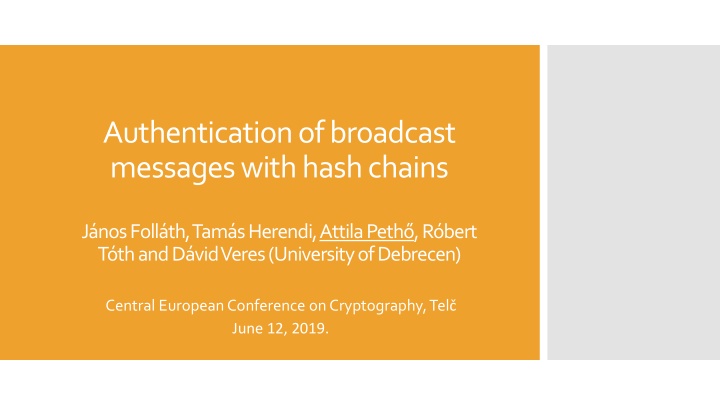
Authentication of Broadcast Messages and Hash Chains
Explore the authentication of broadcast messages using hash chains and its significance in various scenarios such as digital TV, disaster recovery, defense, and more. Learn about challenges, solutions, and the use of hash functions for secure communication.
Download Presentation

Please find below an Image/Link to download the presentation.
The content on the website is provided AS IS for your information and personal use only. It may not be sold, licensed, or shared on other websites without obtaining consent from the author. If you encounter any issues during the download, it is possible that the publisher has removed the file from their server.
You are allowed to download the files provided on this website for personal or commercial use, subject to the condition that they are used lawfully. All files are the property of their respective owners.
The content on the website is provided AS IS for your information and personal use only. It may not be sold, licensed, or shared on other websites without obtaining consent from the author.
E N D
Presentation Transcript
Authenticationof broadcast messages with hash chains J nosFoll th, Tam s Herendi, Attila Peth , R bert T thand D vid Veres(University of Debrecen) Central European Conference onCryptography, Tel June 12, 2019.
Onesender manyreceiver Sender: Powerfull, Whatis broadcasting? has time forpreparation Receivers: limited power, direct action
The Capitoline Geese. SavedRomein390 BC throughcackle, a kindof broadcast message . The messageof geese, dogs, etc is not always authentic.
Authentic broadcasting Town crier, Gemeindediener, krzykacz miejski, kisb r , etc
(Digital) TV and broadcast Sensor networks Spread of data(e.g. share-lists) Smart city Modern applications Autonomous vehicles, Satellite position GPS Disaster recovery Defense
Authentication of sender content Challenges (A. Perrig, 2001) Efficient generation and verification Real-time/instant authentication Individualmessageauthentication Robustness topacketloss Scalability Small size of authentication information.(low communicationoverhead) Secure broadcast communication
Usual: digital signature with asymmetriccryptography Security widelyaccepted, but Complicatedcomputation(receiver sidetoo!) The authenticationinformationis large Solutions Need: electronic signature with symmetric cryptography Solution: hash chains (L. Lamport, 1981, Password authentication with insecure communication)
?: 0,1 0,1? Maps a bitstring of anylength toa string of fix lenght. Easy to computethe image, butveryhardto compute the preimage. Hardtofind collision, i.e. x y suchthat H(x) = H(y). Hashfunction Message Hash value (SHA-256) CF43E029EFE6476E1F7F84691F89C876818610C2EAEAEB881103790A48745B82 alma
Cryptographic construction Segment of an orbitof a hash function: H^k(x), k=0,1, ,n. C0 C1 C2 C3 Hashchain Public data Random string C0 X C2 H(X) C1 KnowingC0itis hard to computeC2, but KnowingC0and x itis easy to verify whether x = C2.
A. Perrig, 2001: BiBa stands for Bins and Balls signature - a collisionof balls under a hash function in bins forms the signature Needs: ?: 0,1 0,1?, hash function, Gh: 0,1? [0,u-1], h=0, 2n-1, family of hash functions, s1, ,sl 0,1?: SEALs = SelfAuthenticating vaLues. Firstexample: theBiBa signature scheme
The BiBa signature scheme
Simplestcase: one hash chain Advanced: more hash chains Generationof theSEALs
BroadcastAuthentication Protocol Secondexample: theTESLA protocol Timed EfficientStreamLoss-tolerantAuthentication A. Perrig, et al. 2002.
Uses simple cryptographicprimitivs Hash functions Hash chains Pseudo random strings MAC (messageauthentication code) Cryptographic ingredients Fromthese symmetric ingrediens a protocolis invented with asymmetric properties.
Client-server application Main functions of theTESLA protocol Time synchronization Broadcasting messages Receiving messages
Properties: Low computation overhead for generationand verification of authentication information. Lowcommunicationoverhead. Limited buffering for the sender andthe receivers Robustness topacketloss Scales to a large number of receivers The TESLA protocol Invented toPCs, later to microcontrollerenvironment
Vital importance The server and the clients haveto be synchronized, enoughthe loose timesynchronization Time synchronization Weimplemented extra applications bothin Server side(PC) and Clientside (PC, Android) After carefulcomparisonwe choosedtheTCP protocol
Generation of the hashchain Importantparameters (default) Lengthof the chain(100) Frequency (1 message/5 seconds) Lengthof retardation(2 interval) Preparationof theserver C10 C11 C6 C7 C8 C9 7. interval 6. interval 11. interval 9. interval 10. interval 8. interval time 5 second
1 yearlifetime, 128 bit hash Storage capacity1 I : message frequency N: lengthof the hash chain
Storage capacity2
Disclosure schedule Includes: Lengthof the chain Frequency of the messages Index of the interval Lengthof retardation Publishedkey Sharingthe publicdata
Message Message MAC Broadcasting C6 C6 C8 C8 C10 C11 C7 C9 7. interval 6. interval 11. interval 9. interval 10. interval 8. interval time
Buffer Message Message zenet MAC MAC MAC C6 C6 C8 8 Receiving messages 7. interval 6. interval 11. interval 9. interval 10. interval 8. interval time
Buffer Message Message MAC MAC C10 C8 Receiving messages C6 C7 C8 7. interval 6. interval 11. interval 9. interval 10. interval 8. interval time
Buffer Message Message Message Message MAC MAC C8 C8 Receiving messages C8 C8 C6 C7 7. interval 6. interval 11. interval 9. interval 10. interval 8. interval time
New implementation inthe operating systemAndroid mobile applications Ourresultson theTESLA protocol Carefulanalyses of the networkrequirements suggested network protocol: UDP
Camera system from Android phones Mobile camera system controlled by a PC The clients are mobile phones with camera Onthe commandof the server they take photo The results (photos) canbe seenona web envorinment A mobile application Security cameras Baby orpetobserver cameras Recycling old mobile phones green informatics
Video presentation https://youtu.be/H7hZOc2XoQs
/unideb-tesla Sourcecodes
Thankyouforyour attention!






















